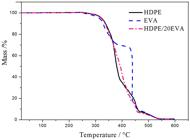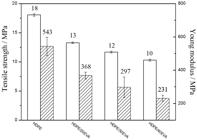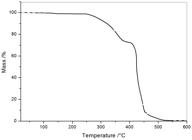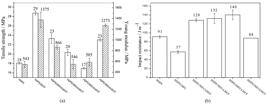Abstract
Short fibers are used in thermoplastic composites to increase their tensile and flexural resistance; however, it often decreases impact resistance. Composites with short vegetal fibers are not an exception to this behavior. The purpose of this work is to produce a vegetal fiber reinforced composite with improved tensile and impact resistance in relation to the polymer matrix. We used poly(ethylene-co-vinyl acetate), EVA, to recover the impact resistance of high density polyethylene, HDPE, reinforced with Curauá fibers, CF. Blends and composites were processed in a corotating twin screw extruder. The pure polymers, blends and composites were characterized by differential scanning calorimetry, thermogravimetry, infrared spectroscopy, scanning electron microscopy, tensile mechanical properties and Izod impact resistance. EVA used as impact modifier in the HDPE matrix exhibited a co-continuous phase and in the composites the fibers were homogeneously dispersed. The best combination of mechanical properties, tensile, flexural and impact, were obtained for the formulations of composites with 20 wt. % of CF and 20 to 40 wt. % of EVA. The composite prepared with 20 wt. % EVA and containing 30 wt. % of CF showed impact resistance comparable to pure HDPE and improved tensile and flexural mechanical properties.
Keywords:
fibers; impact behavior; mechanical testing; extrusion

 Thumbnail
Thumbnail
 Thumbnail
Thumbnail
 Thumbnail
Thumbnail
 Thumbnail
Thumbnail
 Thumbnail
Thumbnail
 Thumbnail
Thumbnail
 and Young modulus
and Young modulus  for the HDPE/EVA blends, as a function of EVA content.
for the HDPE/EVA blends, as a function of EVA content.
 Thumbnail
Thumbnail
 Thumbnail
Thumbnail
 Thumbnail
Thumbnail
 Thumbnail
Thumbnail









